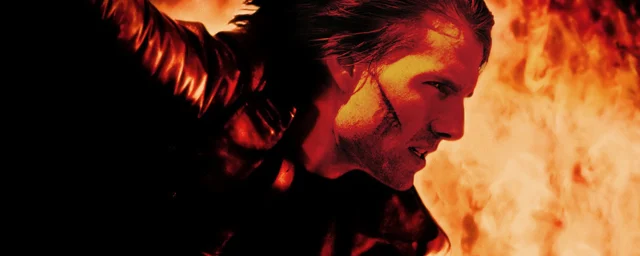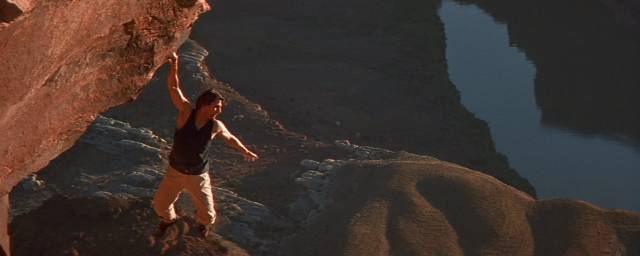D-5 before “Mission: Impossible 7”! To wait until the release, back to previous episodes. And today place in the second, the one in which Tom Cruise did acrobatics and the motorcycle in front of the virtuoso camera of John Woo.
The release of “Mission: Impossible – Dead Reckoning Part 1” is fast approaching. Finally, after many postponements due to COVID. To wait until Ethan Hunt’s return to the cinema, we invite you to come back to the previous opuses, from the style of the staging to the themes, through the highlights.
A session of booster shots which continues with the second episode, virtuoso but less successful on the screenplay level, where Tom Cruise has fun thanks to the staging of John Woo – SPOILERS BEWARE!!!
If you ask a Mission: Impossibke connoisseur to name their least favorite episode, chances are the second one will be mentioned. Well Named.
Because it is the one that has aged the least well. Pure product of the early 2000s down to its credits with accents bare metal signed Limp Bizkit, the only group to have had the honor of revisiting the famous musical theme of the saga and taking the place of the composer of the feature film, here Hans Zimmer, in this exercise.
Released on May 24, 2000 in the United States and July 26 in France, it arrives a year after the Matrix craze, which finished making the Asian model the approach to action with its cables and somersaults, then that Matt Damon has not yet started taking krav maga lessons which will help him renew the genre thanks to La Mémoire dans la peau.
After treating himself to the very best in thriller, Tom Cruise turns to THE big name in action of the moment, the one for whom Hollywood has rolled out the red carpet since the success of Volte/Face: John Wow. Who does not need to be asked to impose his generous style, not stingy with a flight of doves, a slow motion that supports a blow, a fall or a bullet impact.
Or even a sometimes excessive use of symbols, such as this shot which presents Ethan Hunt as an angel of death when he walks in the middle of flames in the bunker where his enemy Sean Ambrose (Dougray Scott) is hiding. A villain who literally wants to be the hero, thus allowing the filmmaker to reconnect with the central theme of his previous feature film thanks to one of the codes of the saga: the masks.
DOCTOR WOO
In Volte/Face, Nicolas Cage became John Travolta (and vice versa) out of necessity. Here, it is as much to satisfy his diabolical plan as because he dreams of being what he is that Ambrose, a former Mission: Impossible agent who has gone over to the dark side, takes on the appearance of Hunt twice: in the opening scene where he steals the Chimera virus from Doctor Nekhorvich (Rade Serbedzija), then to confront Nyah Hall (Thandiwe Newton).
A thief who is none other than her ex, sent back into her arms by Ethan whom she believes she is talking to during this nocturnal interview. It is actually the villain who, a few moments later, takes off his mask, his eyes red with tears. As much because he knows he is betrayed as because he discovers that the young woman prefers his enemy, sending him back a little more to his neuroses.
Paramount Pictures When you realize you don’t look like Tom Cruise
Ambrose will even be taken at his own game during the last third when, believing he is dealing with Hunt, whom he intends to get rid of once and for all, he shoots down his henchman Hugh Stamp (Richard Roxburgh), fooled by an exchange of masks and of faces.
As the hero flees, in slow motion, his enemy’s cry of rage can then be read in two ways: it comes as well from the fact of having been duped in this way, as from noting that Ethan preferred to become someone other than him when dressing up. A sign that fascination only operates in one direction. And a way, for John Woo, to integrate a bit of psychoanalysis into a story imbued with mythology from the first seconds.
In the introductory scene, Doctor Nekhorvich announces that “Any search for a hero must begin with what is indispensable to any hero: a villain”to explain how the Chimera virus preceded the creation of its antidote, called Bellerophon as in Greek mythology.

Paramount Pictures
A monologue that prefigures the structure of the feature film. Because it’s not Ethan Hunt, as one might think, but the evil Sean Ambrose made up who appears to us first. This requires that we then call on the good guy, who thought he could enjoy his vacation and who is asked to play the savior. From Sydney initially and from the rest of the world by extension.
Unlike Brian De Palma, more down-to-earth and focused on a world still marked by the fall of the Soviet bloc, John Woo aims for lyricism. And its foreground, on the Sydney Opera House, announces the color of an opus which aims, precisely, to be operatic.
Even if it means sinking into kitsch and bad taste, as when Ethan and Nyah’s eyes meet, hair in the wind, while their cars skid, glued to each other, a gently supported metaphor of the attraction between two characters. Or when superimposed fades remind us, if need be, that the hero and the villain represent two sides of the same coin.
“It’s not Mission: Hard but Mission: Impossible, Mr. Hunt. Hard would be child’s play for you”
Not content with playing a love triangle story against a backdrop of espionage, like Alfred Hitchcock with Les Enchaînés, the Chinese filmmaker also makes his passion for the musicals of Jacques Demy speak, to whom he admits to paying homage during the meeting between Ethan and Nyah, who takes on the appearance of a pas de deux as flamenco dances between them.
A commendable attempt to make the hero of the saga a romantic character, which is not totally convincing because he lacks this tragic dimension and this shadow of death that he carries with him, and that the following filmmakers will exploit better. It must be said that Mission: Impossible II, by abandoning the team side for a quasi-solo of its star, too often leaves the human part of Hunt aside.
There is of course his love story with Nyah, but this is not strong enough to counterbalance the image of a superman that becomes his from this episode and his first appearance, climbing a cliff at bare hands, with no other script justification than the beauty of the gesture and the piece of bravery.

Paramount Pictures
When you couldn’t choose between motorcycling and water skiing
Certainly impressive images, where the performance seems to take precedence over the staging. What John Woo will catch up with when it comes to action again, and especially during the formidable chase on motorcycles, sometimes without feet. One of the big pieces of cinema of the last twenty-five years.
A real adrenaline rush which confirms all the talent of the director in the exercise and results in the almost literal fusion between the hero and his adversary, to the delight of a Sean Ambrose who will not have time to ‘benefit.
A sequence among the most spectacular of the saga, which allowed Ethan Hunt to establish his status as an American James Bond, and even to surpass his model then embodied by Pierce Brosnan. And this is precisely the trap in which the franchise momentarily fell with this Mission: Impossible II.
Rather than digging its own path, the film tries too hard to make its hero the American counterpart of 007, with a second degree that hardly corresponds to him and an awkward sexualization that often flirts with misogyny. Aspects that will fortunately be left out in the next feature film.
BOND KISSES FROM SYDNEY
A little too anchored in its time on the cinematographic level, for better or for worse, this one is now a parenthesis. And step aside from his character on the scale of the franchise, since there will be no more mention of his events than his protagonists, except Ving Rhames, will be back.
If seeing it again today can make people cringe, Mission: Impossible II has the merit of not being calculating or playing the card of restraint, including when it offers us hazardous reflections embedded in sunglasses.

Paramount Pictures
Little time suspended, calm
Despite its obvious flaws, it resembles its director with a generous style, thus respecting the principle put in place by Tom Cruise when launching the saga on the big screen, where each episode would bear the imprint of its filmmaker.
And even if John Woo is above all at the service of his superstar, more than ever aware of his status and determined to offer himself a gift to his (dis)measurement, the result turns out to be much richer than we could believe it thematically and in its exploration of the struggle between good and evil.
Previous episodes:
- Mission Impossible: when Tom Cruise took our breath away for the first time
Next episode: when Tom Cruise faced the best villain of the saga
